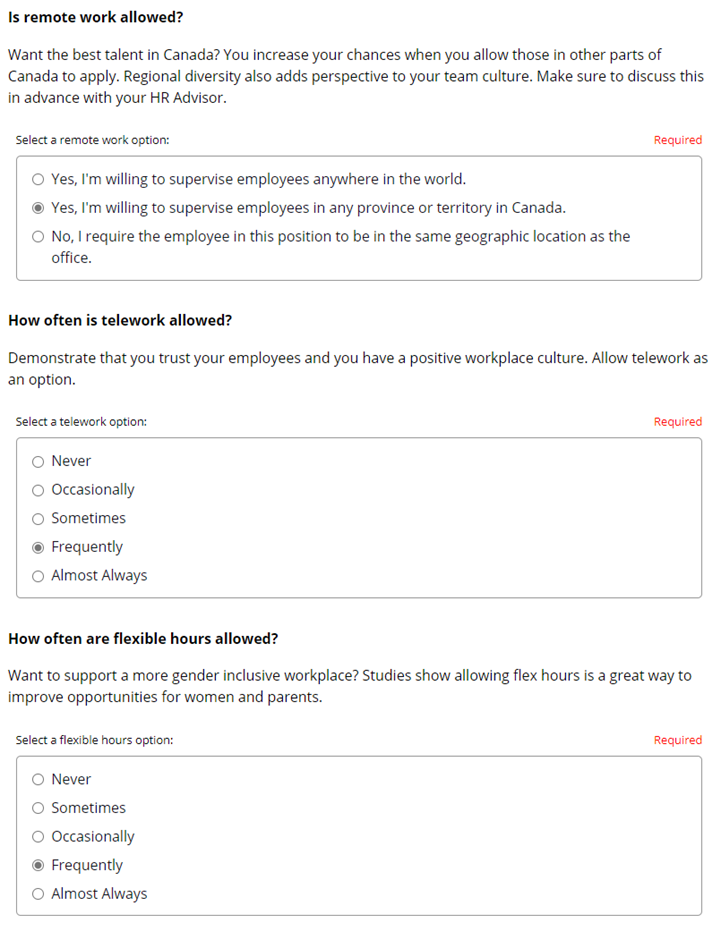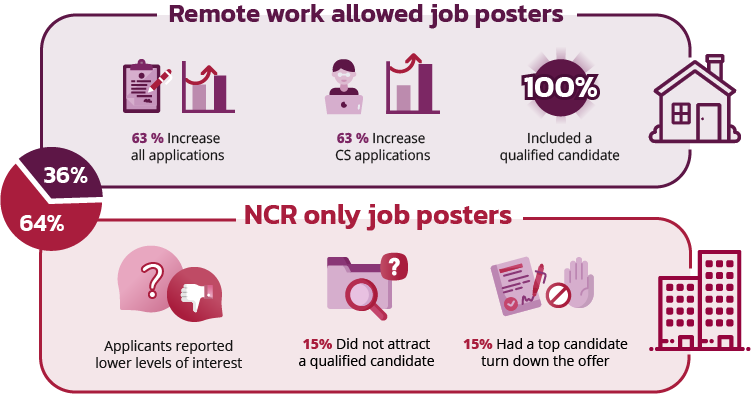The National Capital Region (NCR) accounts for only 4% of Canada’s labour force, but 42% of the Federal Public Service works there. The ability to hire employees to work outside the location of the physical office is a policy flexibility that has not been traditionally used. (Based on workshops with managers and HR advisors, we suspect this was due to a combination of managers not being encouraged to offer this flexibility, and the GC Jobs system default forcing the choice of specified location(s) of work based on government office.)
While many departments also staff positions in regional offices, “work from anywhere” was not a standard hiring practice when Talent Cloud first launched this as a platform-based staffing option in October 2018. (Notably, in January 2021, the Public Service Commission adapted the GC Jobs platform to include this option, largely in response to the impact of COVID-19 on the federal workforce. It’s an exciting development for workers across Canada.)
To promote remote accessible jobs, we engineered a hiring model optimized to allow employees to work from anywhere. The first step is to encourage managers to consider accepting applications from people from outside their geographic region.
Talent Cloud job advertisements tell applicants a lot more about the job than they would see on a typical poster. This includes information about ‘workplace environment’, such as whether the position allows flex hours and whether it is available for remote work.
When managers build a job advertisement, the default selection for remote work is that it is allowed. This is a nudge that forces managers to intentionally exclude remote workers and say that they only want to consider applications from people in their geographic region. In a traditional job process, the opposite has been true (where managers listed a government office location for work, and would have to draft additional text and justifications if remote work was allowed). We make sure to give managers the definition of what ‘remote work’ means right in the tool on the Manager Portal for building job advertisements, and we provide support to managers who choose to assess and/or hire remote workers.
"Opening jobs to remote workers allows managers to tap into a whole new talent pool."


Because of COVID-19, remote work is commonplace, so it is easy to forget that before the pandemic remote work was one of the most desirable perks that an employer could offer, with one study showed that 57% of the workforce said that the option to work remotely is their most prefered perk.
Workers have also been able to assign a dollar-figure to being able to work from home. A 2017 study from Stanford study showed the average worker would be willing to give up 8% of their income to work from home. Remote employees are also able to work from anywhere, and have been shown to relocate to regions with lower costs of living, allowing them to stretch their income further.
Supporting remote work also helps to keep the top talent that you already have! One study showed that 74% percent of knowledge-based industry workers in the United States would quit their job for one that offers remote positions, and that 26% had already left a job for that reason. These findings were supported by another study that showed companies that support remote work have a 25% lower employee turnover rate than those that don’t.
By using a small nudge on the job poster builder, many managers were persuaded to change long-held behaviours and chose to accept applications from remote workers. This gave them access to more talent and made it more likely that they would make a hire.
Government is a huge employer. If this model was permanently applied across GC hiring, it could be a high value social impact at scale and pave the way towards regionally representative diversity in government employment. At the community level, this could aid in accelerating distributed economic recovery, and improve the quality of the Public Service’s talent base.
While the Talent Cloud experiment yielded promising signals, it’s still very small in scale. We’re hopeful there will be larger scale research from other GC HR authorities on the impact of the 2021 change to the GC Jobs platform allowing remote work. We look forward to comparing notes and findings.